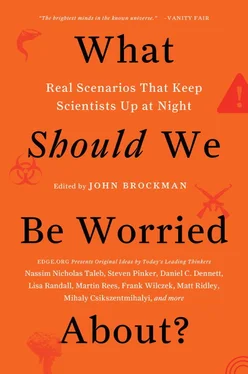The conclusion is simple: It’s too late to worry about alerting the aliens to our presence. That information is already en route at the speed of light, and alien societies only slightly more accomplished than our own will easily notice it. By the 23rd century, these alerts to our existence will have washed across a million star systems. There’s no point in fretting about telling the aliens we’re here. The deed has been done, and the letter’s in the mail.
But what about a policy to limit our future leakage? What about simply calming the cacophony so we don’t continue to blatantly advertise our presence? Maybe our transmissions of the past half-century will somehow sneak by the aliens.
Forget it. Silencing ourselves is both impossible and inadvisable. The prodigious capability of a gravitational-lens telescope means that even the sort of low-power transmissions ubiquitous in our modern society could be detectable. And would you really want to turn off the radar sets down at the airport, or switch off city streetlights? Forever?
In addition, our near-term future will surely include many technological developments that will unavoidably be visible to other societies. Consider powersats—large arrays of solar cells in orbit around the Earth that could provide us with nearly unlimited energy without the noxious emissions or environmental damage. Even in the best cases, such devices would backscatter hundreds or thousands of watts of radio noise into space. Do we want to forbid such beneficial technologies until the end of time?
Yes, some people are worried about being noticed by other galactic inhabitants—beings that might threaten our lifestyle or even our world. But that’s a worry without a practical cure, and the precautions that some urge us to take promise more harm than good. I, for one, have let this worry go.
WILLIAM POUNDSTONE
Journalist; author, Are You Smart Enough to Work at Google?
I worry about augmented reality. It’s an appealing technology that seems completely inevitable in the next twenty years. You’ll wear eyeglasses that are no bulkier than the regular kind, or maybe even contact lenses, and they’ll overlay all sorts of useful information on your field of view. You could have an interactive map, a live news ticker, or notifications of messages—anything you can get on a screen now.
The game-changing thing is not the local-specific overlays (which we’ve already got) but the utter privacy. No one else would know you’re checking scores in a business meeting or playing video games in class. These may sound like silly examples, but I don’t think they are. How often have you not checked your messages because it wasn’t quite socially acceptable to pull out a phone? With eyeglass-mounted augmented reality, all the inhibitions will be gone.
I’m not worried about safety—maybe cars will drive themselves by then. I worry about a world in which everyone is only pretending to pay attention. Our social lives are founded on a premise that has always been too obvious to need articulation: that people attend to the people immediately around them. To not do that was to be rude, absent-minded, or even mentally ill. That’s coming to describe us all. We’re heading toward a Malthusian catastrophe. Consumer-level bandwidth is still growing exponentially, while our ability to deal with seductive distractions is stable or at best grows arithmetically. We will need to invent a new social infrastructure to deal with that, and I worry that we don’t have much time to do it.
STEVEN STROGATZ
Schumann Professor of Applied Mathematics, Cornell University; author, The Joy of x : A Guided Tour of Math, from One to Infinity
In every realm where we exist as a collective—in society, in the global economy, on the Internet—we are blithely increasing the coupling between us, with no idea what that might entail.
“Coupling” refers to the ability of one part of a complex system to influence another. If I put 100 metronomes on the floor and set them ticking, they’ll each do their own thing, swinging at their own rhythm. In this condition, they’re not yet coupled. Because the floor is rigid, the metronomes can’t feel each other’s vibrations—at least, not enough to make a difference. But now place them all on a movable platform, like the seat of a child’s swing. The metronomes will start to feel each other’s jiggling; the swing will start to sway, imperceptibly at first but enough to disturb each metronome and alter its rhythm. Eventually the whole system will synchronize, with all the metronomes ticking in unison. By allowing the metronomes to impose themselves on each other through the vibrations they impart to the movable platform, we have coupled the system and changed its dynamics radically.
In all sorts of complex systems, this is the general trend: Increasing the coupling between the parts seems harmless enough at first. But then, abruptly, when the coupling crosses a critical value everything changes. The exact nature of the altered state isn’t easy to foretell. It depends on the system’s details. But it’s always something qualitatively different from what came before. Sometimes desirable, sometimes deadly.
I worry that we’re playing the coupling game with ourselves, collectively. With our cell phones and GPS trackers and social media, with globalization, with the coming Internet of things, we’re becoming more tightly connected than ever. Of course, maybe that’s good. Greater coupling means faster and easier communication and sharing. We can often do more together than apart.
But the math suggests that increasing coupling is a siren’s song. Too much makes a complex system brittle. In economics and business, the wisdom of the crowd works only if the individuals within it are independent, or nearly so. Loosely coupled crowds are the only wise ones.
The human brain is the most exquisitely coupled system we know of, but the coupling between different brain areas has been honed by evolution to allow for the subtleties of attention, memory, perception, and consciousness. Too much coupling produces pathological synchrony, the rhythmic convulsions and loss of consciousness associated with epileptic seizures.
Propagating malware, worldwide pandemics, flash crashes—all symptoms of too much coupling. Unfortunately, it’s hard to predict how much coupling is too much. We know only that we want more, and that more is better… until it isn’t.
HOMOGENIZATION OF THE HUMAN EXPERIENCE
SCOTT ATRAN
Anthropologist, National Center for Scientific Research, Paris; author, Talking to the Enemy: Faith, Brotherhood, and the (Un)Making of Terrorists
More than half a million years ago, the Neanderthal and human branches of evolution began to split from our common ancestor Homo erectus. Neanderthal , like erectus before, spread out of Africa and across Eurasia. But our ancestors, who acquired fully human structures of brain and body about 200,000 years ago, remained stuck in the savanna grasslands and scrub of eastern, then southern Africa. Recent archaeological and DNA analyses suggest that our species may have tottered on the brink of extinction as recently as 70,000 years ago, dwindling to fewer than 2,000 souls. Then, in the geological blink of an eye, they became us, traipsing about on the moon and billions strong.
How did it happen? No real evidence has emerged for dramatic change in general anatomy of the human body and brain or in basic capacities for physical endurance and perception. The key to this astounding and bewildering development may have been a mutation in the computational efficiency of the brain to combine and process concepts—a recursive language of thought and theory of mind—that led to linguistic communication about possible worlds and to a mushrooming cultural cooperation and creativity within and between groups to better compete against other groups.
Читать дальше












